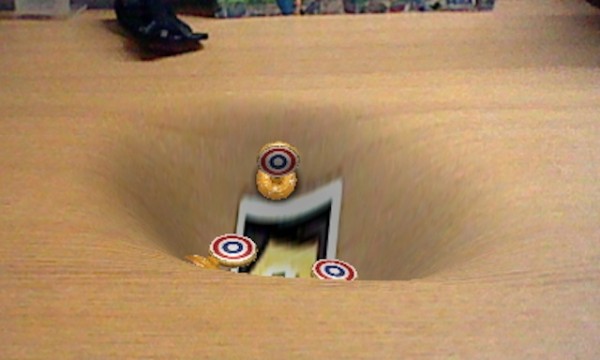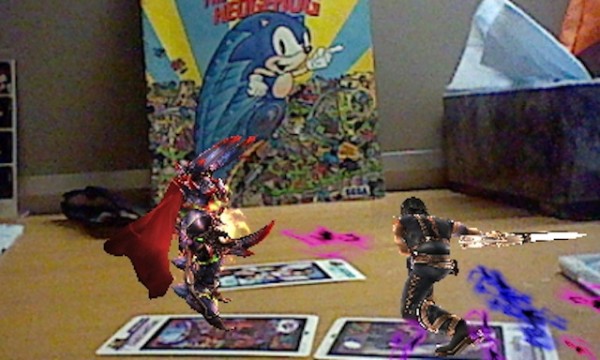
Does anybody remember what Nintendo 3DS was like when it first launched? Being an early adopter, I remember it all too clearly. There was not one piece of software that interested me and the eShop wasn’t even functional, but I absolutely had to get my hands on this revolutionary piece of technology after seeing it debut at E3 2010. I needed to experience glasses free 3D for myself, even if there was a huge lack of content on the system. So, like many other people that didn’t know what to do with a 3DS after they purchased it at the time, I explored the built-in software.
I knew that the built-in software featured augmented reality games from reading plenty of press coverage online, but I wasn’t sold on the idea of it until I started to actually play them. Seeing the world around me through my handheld’s camera alter in different ways unexpectedly delighted me. I watched as my desk warped into a complex mini golf course, manifested a forest full of targets to shoot, and transformed into a pond filled with fish. It left such a huge impression on me that when people asked me what was so great about 3DS, I showed them AR game Face Raiders by taking a picture of their face and letting them battled a horde of flying heads that resembled themselves. I was met with positive reception, and I couldn’t wait to see what Nintendo would do next with this feature.

Fast-forward to the present. Augmented reality has been ignored and barely utilized at all, since developers opt not to include it in their games. No one, including myself, talks about AR games at all. People around me are starting to buy 3DS systems left and right, but the built-in software is not something these new 3DS owners seem to care about. What happened to AR games?
Well, the truth of the matter is that the technology, for the most part, is lacking in a lot of areas. The cameras on the system are really bad, with fuzzy picture quality that lacks the clarity found within cameras found on a common smartphone. The camera is also poor at capturing light, which is a significant problem to any AR game that requires a card since a projected image’s stability is determined by how bright a room is. The other problem is that the player should stay roughly 14 inches away from the card in order to keep the projected image running, which is annoying in itself but even worse if the game uses gyroscopic controls. Losing the augmented reality image breaks immersion, and winds up frustrating a player trying to get engrossed within the experience. Not only that, but the frame rate lowers immensely when too much is going on at once.
However, despite all of these technical flaws, I am still compelled by the concept of AR games. There is so much potential in creating an innovative experience around this technology that hasn’t been fully explored yet. The built-in software was nice, but it was only a tech demo that displayed what AR games could achieve on 3DS. What I’d love to see is a more full-fledged AR game in the works, but such an expectation is probably unrealistic.
Spirit Camera: The Cursed Memoir is a perfect example of an AR game that could have been amazing, as it had an incredible concept that was waiting to be fleshed out. This full retail 3DS title was a survival horror game that had gameplay that was based completely on the AR and gyroscope technology of the handheld. In the game, a girl named Maya gets trapped within a book called the Diary of Faces, which comes with the game as an AR booklet that functions a lot like the AR cards that come with the system. Telling this game’s horror story through a mysterious diary that displayed AR images is an innovative gameplay idea that could lead to a very compelling experience.

However, the execution of this game was incredibly poor. Critics slammed the game for having a predictable story that lasted roughly two hours long, which mostly plays out as an interactive novel, and a repetitive combat system that involved taking pictures of your foes that plays worse than fights found in Face Raiders. The problems don’t stop there, as the aforementioned problems with the AR technology also come into play, most notably the need to be in an immensely bright room while playing. The idea of it being impossible to play a horror game in a dark setting is a bit preposterous. Despite being a failure, Spirit Camera was ambitious in what it set out to do, and I would love to see a more solid foundation for such a great idea.
I also see a ton of potential in the small AR component of Kid Icarus: Uprising. This game came bundled with AR cards that displayed characters from the game, and when two cards were put facing together, they could duke it out in an RPG-styled brawl. Each card had its own stats for health, attack, and speed, which helped determine who would win each fight. However, there wasn’t much to card battling, as you do not get to interact with the characters fighting and the same cards always produced the same exact results. There are also only six cards included with the game, so playing around with this small add-on got dull within the first few minutes.
Despite this AR card-battling feature being lackluster, it sets an example for what could be done on 3DS. I absolutely love the Pokémon Trading Card Game on Gameboy Color, and I can’t stop thinking how incredible AR features for real Pokémon cards would be. If it were possible to put two Pokémon cards next to each other and see them pop out and battle each other, I’d consider buying booster packs for the first time in over a decade! It doesn’t even have to be Pokemon, as any kind of AR game of this magnitude would be immensely entertaining. All Kid Icarus: Uprising was lacking were numerous playable cards, player input for attacks, and no predetermined fights. If it were fleshed out all the way, it could have turned into something truly special.

I only cited two possible ideas for AR games that have gotten me really excited, but in reality, the ideas for such an unexplored feature are limitless. However, the future for AR games looks meek on 3DS. The only recent implementation of the feature I can find is in Mario Party: Island Tour, as some of the minigames require the use of an AR card. While I am unsure how they are fully utilized and how many AR minigames exist, those that have previewed the game are already complaining about jarring frame rate issues. So, even if Nintendo chooses to pursue AR games in the future, chances are the experience will be held down by technological limitations. Maybe we have to wait for the technology to improve before developers will experiment with augmented reality, but I’d love to see another bold attempt to create a full experience like Spirit Camera: The Cursed Memoir tried to accomplish. There are so many interesting augmented reality ideas that could redefine this forgotten feature as a legitimate way to experience games, and I’d love to see at least one come to fruition and succeed.
What do you think of AR games? Would you like to see more of them, or do you want nothing to do with them? Let us know in the comments!




 ShareThis
ShareThis







Nice piece. I think your idea for Pokemon cards getting AR functionality is spot-on; I’d love to see that, too. And what is that awesome Sonic thing in the background??
It’s a Look and Find Sonic the Hedgehog book! It works like a Where’s Waldo book set in Sonic’s universe, and it’s absolutely brilliant.